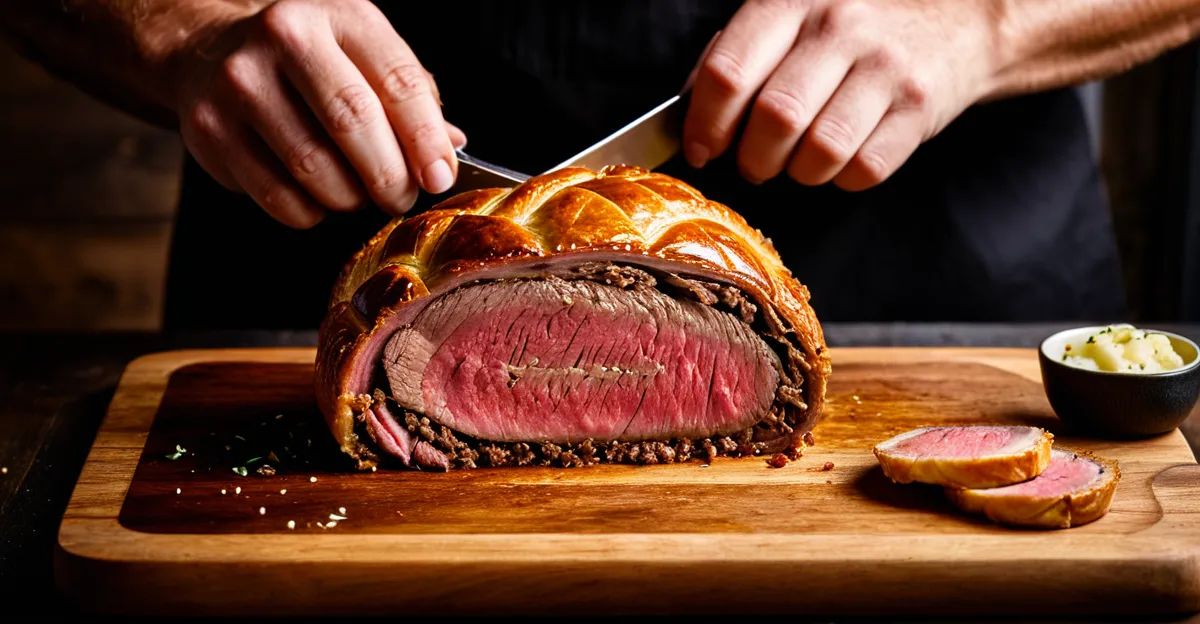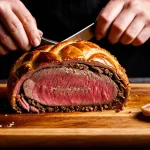Essential Ingredients and Tools for Beef Wellington
To master a classic beef Wellington, selecting the right ingredients and kitchen equipment is crucial. The foundation lies in a high-quality beef fillet—preferably center-cut—for tenderness and flavor. Surrounding this core is the mushroom duxelles, a finely chopped mixture of mushrooms, shallots, and herbs, providing moisture and depth without sogginess. Adding layers like prosciutto or pâté enhances richness and protects the beef during baking. The pastry wraps everything in a golden, flaky crust—typically a quality puff pastry—carefully handled to ensure crispness.
Necessary tools include a sharp chef’s knife for precise trimming and chopping, and a heavy skillet for searing the beef fillet evenly to lock in juices. A food processor can expedite mushroom duxelles preparation, ensuring uniform texture. For assembling and baking, a pastry brush for glazing and an oven thermometer maintain ideal temperature control essential to achieve perfect doneness while preserving crust flakiness. Additionally, a wire rack and baking sheet facilitate proper airflow, preventing soggy bottoms. With these ingredients and tools, the cooking process becomes manageable while guaranteeing the hallmark qualities of beef Wellington: a juicy interior, robust flavors, and a crisp, golden exterior.
Also read : What are some creative ways to cook with British root vegetables?
Preparing the Beef: Searing and Seasoning
Proper beef preparation begins with thorough seasoning and searing—a critical step to achieve a juicy, flavorful beef Wellington. First, the beef fillet should be patted dry to ensure an even sear. Generously season with salt and freshly ground black pepper to enhance the natural meat flavor. Searing the beef fillet in a hot, heavy skillet—preferably cast iron—locks in juices by creating a caramelized crust. This process typically takes 2-3 minutes per side, including the edges.
Why is searing essential? It initiates the Maillard reaction, which develops complex, savory notes on the beef’s surface. This crust not only adds taste but also serves as a barrier, retaining moisture during baking.
Also to discover : What are the essentials for a perfect afternoon tea spread?
After searing, allow the fillet to rest and cool before proceeding. This cooling prevents the puff pastry from becoming soggy and aids in achieving a perfectly cooked interior. Remember, the quality of seasoning techniques impacts the final dish as much as the kitchen equipment used. Heat control during searing is crucial; too high can burn the surface, too low won’t form the crust needed to seal in the juices effectively.
Crafting the Mushroom Duxelles and Additional Fillings
Creating a well-balanced mushroom duxelles is fundamental for that signature earthy depth in your beef Wellington filling. Begin by finely chopping mushrooms into a consistent texture, ideally with a food processor to save time. Cook the mushrooms slowly over medium heat to release moisture; this gradual evaporation is crucial to avoid sogginess. Incorporate finely minced shallots and fresh herbs such as thyme or parsley to boost aromatic complexity. Season lightly with salt and pepper during cooking to build flavor.
Beyond duxelles, additional fillings enhance richness and texture. Thinly sliced prosciutto adds a delicate saltiness and acts as a moisture barrier, while pâté introduces smooth, luxurious notes. Layering these correctly is essential: spread duxelles evenly over the prosciutto, which wraps the seared beef fillet, creating a flavorful shield that locks juices in and prevents the pastry from becoming wet.
Mastering the balance and integration of the duxelles and other fillings elevates the beef Wellington, ensuring robust flavors and a refined texture. Properly prepared fillings serve as both flavor enhancers and practical components, facilitating a visually appealing, well-structured dish.
Assembling the Beef Wellington
Assembling beef Wellington demands precision in layering to ensure robust flavors and maintain structural integrity. Begin by laying out the prosciutto slices on cling film, forming a protective layer around the seared fillet. Spread an even blanket of mushroom duxelles atop the prosciutto; this adds moisture control and intensifies the beef Wellington filling’s earthiness. Carefully position the cooled, seared beef fillet on the duxelles, then use the cling film to tightly wrap the entire assembly into a uniform log shape. Refrigerate briefly to firm it up, which aids in easier handling during pastry wrapping.
When wrapping the beef Wellington in puff pastry, ensure the pastry sheet is large enough to enclose the filling fully without gaps. Brush the edges with beaten egg yolk as a natural glue to seal the pastry and prevent leaks. Fold and tuck the pastry gently but snugly, avoiding stretching which can cause tearing. Excess flour should be brushed off to ensure proper adhesion. This meticulous assembly process prevents sogginess by restricting moisture escape and guarantees the perfect balance of textures: a crisp, flaky crust enveloping juicy, seasoned filling.
Mastering these layering techniques streamlines cooking and enhances both flavor and aesthetics in the final beef Wellington presentation.
Tips for a Flaky Pastry Crust
Achieving a flaky pastry crust is vital to the success of beef Wellington. Start by selecting high-quality puff pastry—preferably all-butter varieties—known for their superior texture and flavour. When handling the pastry, keep it cold to prevent the butter layers from melting prematurely, which can ruin flakiness. Work swiftly but gently to avoid stretching or tearing the dough.
Chilling the assembled Wellington briefly before baking firms the pastry, enabling it to hold its shape and rise evenly. This step reduces the risk of sogginess by allowing the surface moisture to settle. Use a pastry brush to apply an even glaze of beaten egg yolk over the puff pastry; this not only imparts a golden colour but also strengthens the crust’s surface, helping it retain crispness.
Avoid overcrowding the oven or opening the door frequently, as temperature fluctuations compromise puff pastry’s delicate layers. A light dusting of flour during rolling and folding aids in preventing sticking but brush off excess flour before baking to ensure a smooth finish.
Mastering these puff pastry tips elevates the crust texture, giving beef Wellington its signature crispness and visual appeal while complementing the juicy interior.
Baking Guidelines and Temperature Control
Controlling oven temperature is pivotal for achieving ideal beef Wellington baking results. The recommended baking temperature typically ranges between 200-220°C (390-430°F). This range ensures the puff pastry crisps evenly while allowing the beef fillet to cook to the desired doneness without drying out. Baking at too high a temperature risks burning the crust before the beef is cooked, whereas too low results in a soggy pastry and undercooked meat.
Accurate doneness is best monitored using a meat thermometer inserted into the fillet center. For medium-rare, target an internal temperature of 54-57°C (129-135°F); for medium, 60-63°C (140-145°F). Remove the Wellington from the oven slightly before reaching these marks, as residual heat continues cooking during resting.
Allow the beef Wellington to rest for 10-15 minutes post-baking to distribute juices evenly, preventing dryness when sliced. Placing the Wellington on a wire rack during baking supports airflow, enhancing bottom crispness and avoiding soggy bottoms.
In summary, precise temperature control combined with thoughtful resting produces a beautifully cooked beef Wellington, marrying a flaky crust with a perfectly tender, juicy interior.
Troubleshooting Common Beef Wellington Challenges
Avoiding a soggy bottom is essential to maintaining a crisp, flaky crust in beef Wellington. This issue often arises when excess moisture seeps from the beef Wellington filling into the pastry. To prevent this, ensure the mushroom duxelles are cooked thoroughly to evaporate moisture, and use moisture barriers like prosciutto or pâté during assembling beef Wellington. Placing the Wellington on a wire rack in the oven improves airflow beneath, which also helps keep the base crisp.
Beef overcooking is a common pitfall. Using an accurate meat thermometer during beef Wellington baking lets you monitor the oven temperature and internal doneness precisely. For medium-rare, target 54-57°C (129-135°F). Remove the Wellington from the oven slightly before the target temperature because residual heat completes cooking during resting. This technique prevents drying out the beef fillet while ensuring it is safe to eat.
If the pastry cracks or leaks, review your wrapping beef technique. Avoid stretching the pastry, and seal edges firmly with egg wash. Chilling the wrapped Wellington before baking enhances structural stability. Addressing these common issues helps maintain the desired balance between a tender, juicy interior and a perfectly crisp crust.





